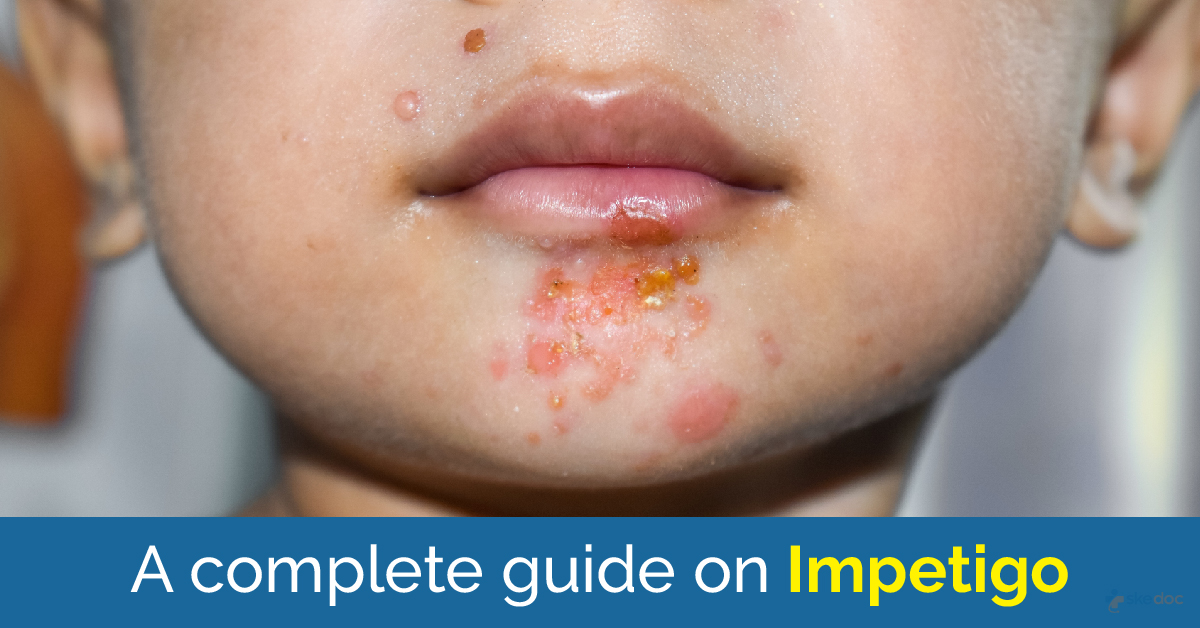Allergy
Blood Diseases
Bone & Joints
Brain
Cancer
Child Care
Cosmetic Surgery
Diabetes
Endocrinology
ENT
Eye
Gen Medicine
General Surgery
Heart
Kidney
Lifestyle
Liver & Digestive
Lung
Men’s Health
Mental health
Physiotherapy
Rheumatology
Skin and hair
Sleep Disorders
Spine
Transplant
Women Health
Thyroid
Vascular Surgery
Impetigo

What is Impetigo?
Impetigo is a bacterial infection of the superficial layers of the skin that is highly contagious and is more commonly seen in children. The face, arms, and legs are usually affected, while the groin and the armpits may also be involved. It is more common in regions with a hot and humid climate.
Is Impetigo a Medical Emergency?
Impetigo is not a medical emergency.
Types
Impetigo is of the following types:
- Nonbullous impetigo or contagious impetigo or impetigo contagiosa
- Bullous impetigo: More common in children below the age of 2 years
- Ecthyma: A variant of non-bullous impetigo with deep ulceration
Causes
It is caused when there is bacterial colonization of the superficial layers of the skin (epidermis) by bacteria such as staphylococcus aureus (most common) or streptococcus pyogenes. The colonization of the skin with the bacteria happens when the intact structure of the skin is broken due to scratching, or other skin infections, scabies, trauma, burns, insect bites, or surgery. It is highly contagious, and contact with the sores and lesions or the secretions from these lesions result in the disease being transmitted.
Risk Factors
The following are the risk factors for impetigo:
- Age: Children below the age of 5 years are more commonly affected
- The warm and humid climate
- Close contact with other kids as seen in creches, playschools, child care centres, etc
- Sports such as wrestling, kabaddi, and judo, where there is a skin to skin contact
- Broken skin: As seen in trauma, scratching, insect bites, burns, scabies, varicella, surgery, etc
- Immunocompromised individuals: HIV/AIDS, chemotherapy, steroid therapy
MRSA, which is Methicillin-resistant Staphylococcus aureus, is a severe and stubborn bacteria that is resistant to a lot of antibiotics, and it can cause this disease in the following cases:
- Healthcare and hospital workers
- Hospitalization for a prolonged period
- Residents of long-term care facilities
- Having chronic indwelling catheters or medical devices
Signs & Symptoms
The following are the symptoms and signs of impetigo:
- Red sores
- Sores rupture and ooze a serous liquid for a few days
- Once the oozing stops, a yellowish-brown or honey-colored crust is formed
- Sores are more often seen around the nose, lips and the mouth
- The infection can spread to any part of the body
- Fluid-filled blisters are seen in the bullous impetigo, which quickly burst and then form a crust
Investigations
Investigations are usually not required for the diagnosis of this disease; however, the following may be done through:
- Bacterial culture and sensitivity: To identify the presence of MRSA
- Serum Immunoglobulins: If recurrent impetigo is seen; it is done to eliminate immunodeficiency
- Bacterial culture of the nares: Is done to check if the individual is a carrier of aureus
Diagnosis
Diagnosis of impetigo is made based on medical history, clinical evaluation, and results of the investigations, if any.
Treatment options
Treatment of impetigo is aimed at local wound care and eliminating the infection.
Medical management
Medical management of impetigo may include:
- Topical antibiotic: Such as mupirocin, fusidic acid, and retapamulin; if this disease is limited or localized
- Systemic antibiotics: If there is extensive involvement; it is also given to athletic teams, family members, etc
Role of diet/exercise/lifestyle changes/preventive measures
Some measures that can help in the prevention of this disease may include:
- Children with this disease should avoid contact with other children and avoid school and daycare for at least 24-48 hours after starting antibiotic treatment
- Taking proper care of wounds by washing with gentle soap and warm water and applying a topical antibiotic
- Washing an infected individual's clothes and bed linen of an infected individual separately and every day
- Wearing gloves while attending to individuals affected by this disease
- Keeping the nails of children trimmed and clean
- Practicing and teaching children to practice good hand hygiene
Complications
The complications of impetigo may include:
- Kidney dysfunction
- Post streptococcal glomerulonephritis
- Staphylococcal scalded skin syndrome (SSSS)
- Osteomyelitis
- Septic arthritis
- Cellulitis
- Erysipelas
- Urticaria
- Septicemia
Prognosis
The prognosis for this disease, which is diagnosed early and treated promptly, is excellent. Complications may occur more commonly in very young children or infants who are also immunocompromised.
When to contact the doctor or hospital/how to identify the emergency or complications?
It is advisable to seek immediate medical attention if the symptoms and signs of this disease are noticed.
Indications for hospitalization if required
Hospitalization is not required to manage this disease unless severe complications develop.
Suggested clinical specialists/departments to consult for this condition
Specialists from the Department of Dermatology and pediatric dermatology will attend it.
Was this article helpful?
YesNo




